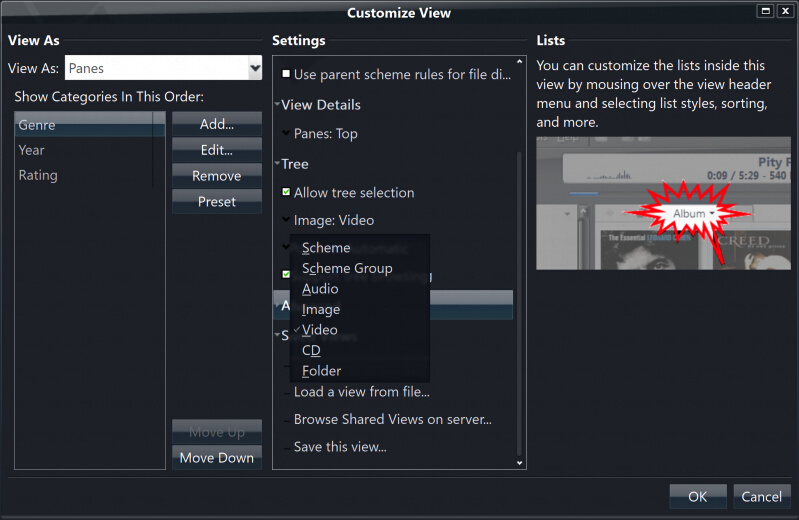I just mean by the assignable icon type that can be applied to any view. For the most part it's essentially like a pseudo media type with a few additions.
Yeah them being calculated on access, well right now we can flag a custom field with it's calculated data to on calculate on access, if the media sub type of a view scheme is set to audio or video, etc.

Having an extra flag field, I guess we can forget about flagging, Audio, Image, Video, Data & TV, as the goal in mind is already achievable for those subsets with media type flags. The addition of being able to flag scheme, scheme groups, CD and folder view scheme types in a custom field, even though they aren't media types would add an extra layer to being able to sub divide calculated fields and where and which they operate on access.
Like audio for instance. I have a custom field that does some things with Artist, Album artist and a custom remixer field I made, populated on a per track basis. I can't explain how it works the best of the top of my head now, MrC helped me and well, I asked and he created view schemes with regex and global variables, with and using custom fields to hold some calculate data. Amongst other calculated fields I've made specifically for certain views. Well it's to my understanding. If a calculated field is ascribed and flagged to audio only. Then such calculated data will never execute on any view where the media type is set to video only.
Although for every view scheme flagged to audio only, that calculated field to my knowledge, is calculated and labour intensive depending on how complex the expression is, if it dynamically updates somehow from other input or calls upon another field or calculated field, in that in every audio view, regardless if that field is used in an expression or category pane, I think it's still accessed and calculated? As it is accessible and can be seen in the tagging window. Does that not mean it's being accessed, on opening of a view?
So being able to ascribe flags for certain custom fields to lets say, they only appear in the tagging window and calculate their expression on access for a view scheme with the image type set to scheme or scheme group. It would allow partial redesign in my library. I could assign maintenance type views, which could utilise maintenance only custom calculated fields, which wouldn't ever slow down the on access time of opening another view that isn't a scheme group, as the calculated field will never be populated unless I actively open the maintenance views.
Maybe I've misunderstood some integral operations of the program itself. Wouldn't be the first time.
Actually that you mention it. I recently been perusing github. Believe it or not, I downloaded your ZStats today before seeing this, I haven't used it yet. I'm not a programmer but I love computing and programming, in that I wish I could program. I studied computer networking at college level got into third year at university for networking, but the difference between college and university here in Scotland is stark in that college is closer to a school than it is university. So when I started in third year, mind you I come from a rural remote village, the contrast in enormity of size of the camput and location compared to what I was used to, I didn't like it. So I didn't stick it out.
It was a bit overwhelming and I felt underprepared in that, what was taught in the latter years of college leading into third year at university, what we had been learning as opposed to what we were expected to already know was nothing alike. I felt I should have just started at first year university rather than the college route and I should have chosen programming. No disrespect to networkers, but programmers, might not be doing the manual graft of networkers but they still know the ins and outs the networking technology, as for most programs, having grasp of computer networks is needed, especially when programmatically developing for networking itself. Generally and mostly those in the field of networking, don't need to know anything about programming.
I've recently just started to get the grasp of github a little, in understanding, as before I never saw the wood for the trees. In that the software github contained, I focused on that, I never really paid much attention to git itself. It's pretty remarkable in that although it's made for coding, it can be used for so many things. Like it may be overkill bit imagine having historical git like operations in MC itself. Being able to record the progression of a media library over time, view a historical graph, rewind to any point. Branch off and merge branches later on, working probably solely on sidecar files rather than the media itself as the git repository would swell with media. But for reversing file naming operations to any recorded point in the libraries history could be useful.
There so many cool projects on GitHub though, I'm finding myself hard pressed for time in exploring there and learning. I'm currently experimenting with Rclone and the first ever program I actually complied from source. rar2fs. But with rclone, I'm setting up remote mounted drives that are stored in RAM. I don;t know how stable it is but I'm considering setting the cache of many a program I use to use a RAM drive, so that it reduced the wear and tear on my physical drives.

 Author
Topic: Feature Idea: Custom field calculated data flag to view scheme tree image type (Read 637 times)
Author
Topic: Feature Idea: Custom field calculated data flag to view scheme tree image type (Read 637 times)

